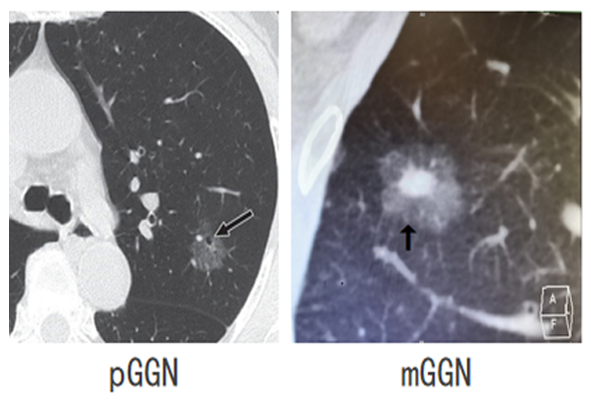National Cancer Report 2022
In February, 2022, the National Cancer Center released the latest issue of national cancer statistics. The National Cancer Registration Center is responsible for the collection, quality control, summary, analysis and release of national cancer registration data. (as the data of the National Cancer Registration Center generally lags behind, the data released in this report is the data collected and summarized by the National Cancer Registration Center for 2016.)
Based on the latest data of the National Cancer Center, the study selected 487 high-quality monitoring sites from 682 cancer monitoring sites nationwide, covering a population of 380million, and elaborated on the cancer disease burden in China in 2016. Compared with 2015, the number of monitoring points reporting statistical data has increased by 181, and the number of high-quality monitoring points has increased by 119, indicating that the coverage of tumor registration in China has been gradually promoted, and the data quality and standardization have been further improved, providing a more powerful scientific basis for the formulation of national health policies.

one
Cancer incidence in China in 2016
1.1 basic information
New cases: 4.064 million
World standard incidence rate: 186.46/100000
Male is higher than female (207.03/100000 vs 168.14/100000)
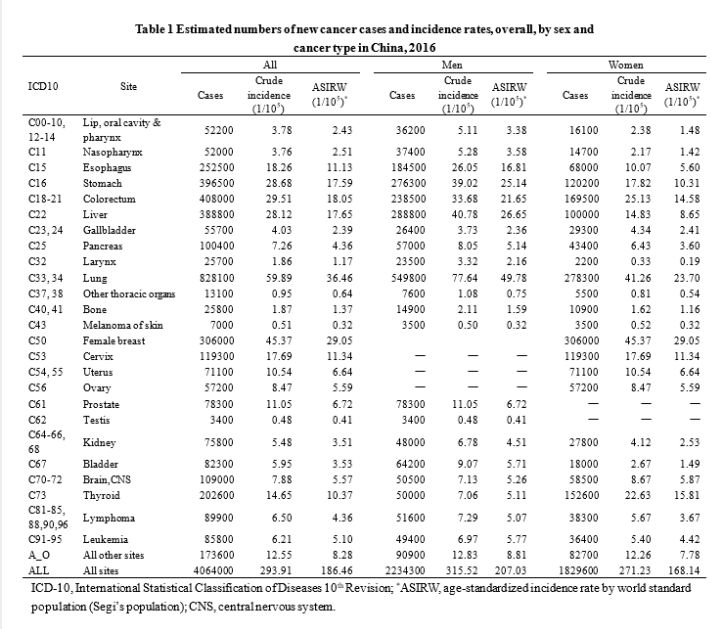

sex difference
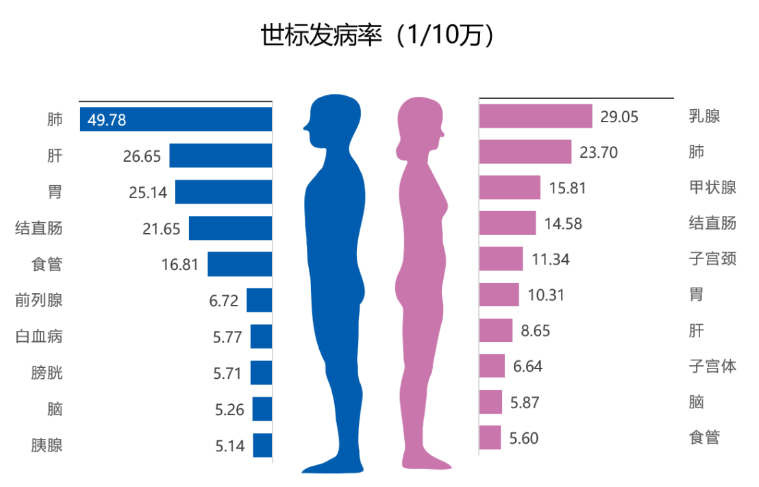
1.2 age differences
Male higher than female: 0~19 years old, over 60 years old
Female higher than male: 15~59 years old
Peak value: the peak value of new cancer cases in both men and women is 60~79 years old

1.3 regional differences
Overall, urban areas are higher than rural areas (189.7/100000 vs 176.2/100000)
Urban higher than rural: lung cancer, breast cancer, colorectal cancer, prostate cancer
Higher in rural areas than in urban areas: gastric cancer, liver cancer, cervical cancer, esophageal cancer

two
Cancer deaths in China in 2016
2.1 basic information
Total death toll: 2414000
World standard mortality rate: 105.19/100000
Male is higher than female (138.14/100000 vs 73.95/100000)
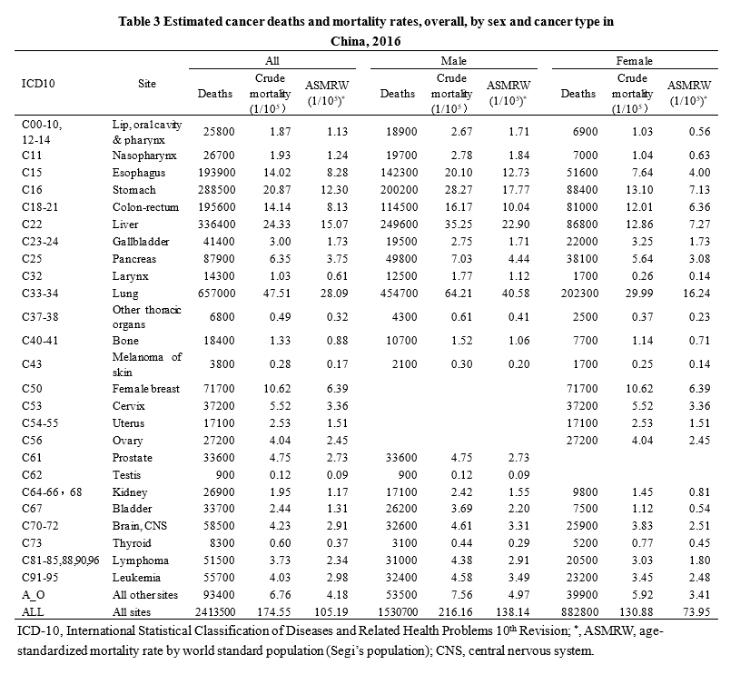
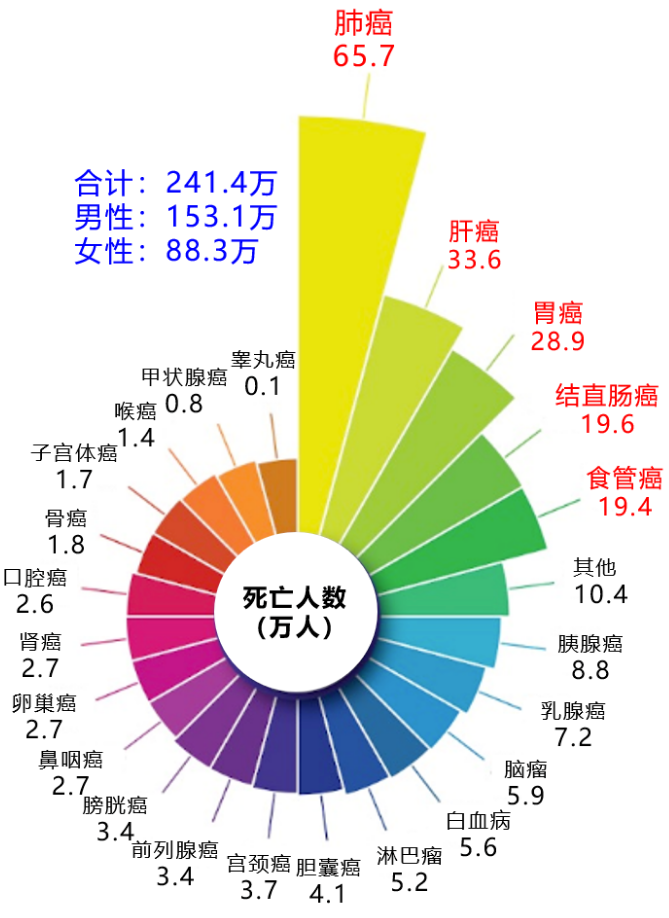
2.2 gender differences
All age groups: male deaths are higher than female deaths
Mortality rate of women is higher than that of men: gallbladder cancer and thyroid cancer
Higher mortality in men than in women: all other cancers

2.3 age differences
Male higher than female: 0~14 years old, over 60 years old
Female higher than male: 15~59 years old
The highest mortality rate: 60~79 years old
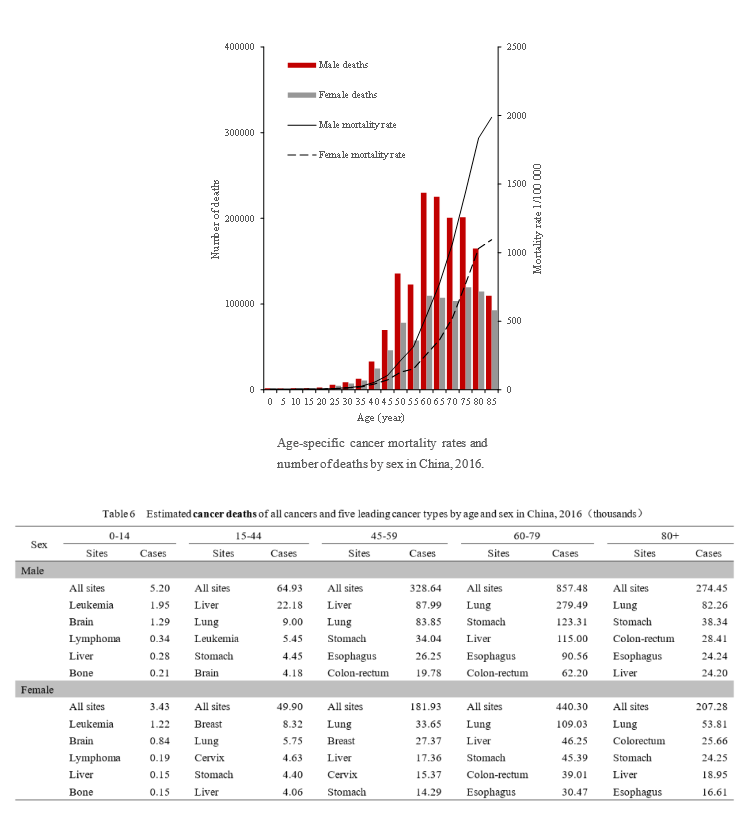
2.4 regional differences
Overall, rural areas are higher than urban areas (106.1/100000 vs 102.8/100000)
Urban higher than rural: lung cancer, colorectal cancer, breast cancer, prostate cancer
Rural areas are higher than urban areas: liver cancer, gastric cancer, esophageal cancer, cervical cancer
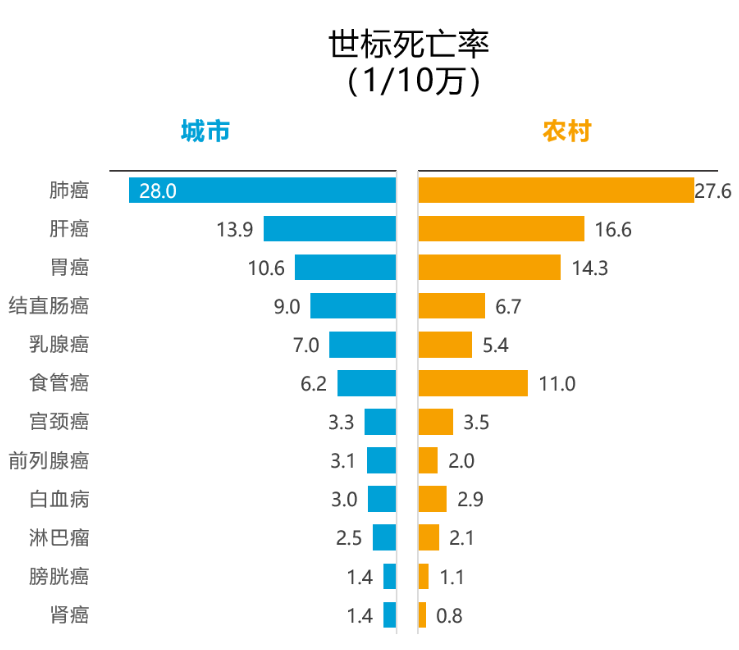
three
Trend of cancer incidence rate and mortality in China from 2000 to 2016
3.1 incidence trend
rise:
Male: prostate cancer, colorectal cancer, leukemia, brain cancer, pancreatic cancer and bladder cancer
Female: thyroid cancer, cervical cancer, uterine cancer, breast cancer, brain tumor, lung cancer, colorectal cancer
Descent:
Men and women: esophageal cancer, gastric cancer, liver cancer
3.2 death trend
rise:
Male: prostate cancer, colorectal cancer, pancreatic cancer, leukemia
Female: cervical cancer, thyroid cancer, breast cancer
Descent:
Men and women: esophageal cancer, gastric cancer, liver cancer, lung cancer
Trends in incidence rate and mortality of some cancers in men and women from 2000 to 2016. A: Male incidence rate; B: Female incidence rate; C: Male mortality; D: Female mortality.

four
summary
4.1 incidence
The overall incidence rate of cancer in China continues to rise, reflecting the heavy burden of cancer in China;
The first incidence: lung cancer in men and breast cancer in women;
The incidence rate in urban areas was higher than that in rural areas;
The traditional high incidence of esophageal cancer, gastric cancer, liver cancer and other tumors in China showed a continuous downward trend, but the disease burden is still heavy;
The incidence of colorectal cancer, breast cancer, thyroid cancer, prostate cancer and other tumors with high incidence in developed countries continues to rise, and the situation of prevention and control is grim.
4.2 deaths
The crude mortality rate of cancer in China still shows an upward trend, but after adjusting the age structure of the population, the standardized mortality rate shows a downward trend, which reflects that the comprehensive prevention and control of cancer in China has achieved preliminary results in recent years;
The first cause of death was lung cancer in both men and women;
The mortality rate in rural areas is higher than that in urban areas;
The mortality of esophageal cancer, gastric cancer, liver cancer and other tumors with high incidence and poor prognosis in China has decreased year by year, but the mortality of cervical cancer is still on the rise;
The mortality rate of colorectal cancer, breast cancer, thyroid cancer, prostate cancer and other tumors with high incidence in developed countries continues to rise.
At present, the incidence and death of malignant tumors in China continue to rise, and the annual medical expenses caused by malignant tumors exceed 220billion. The results of urban-rural analysis show that the incidence rate in urban areas is slightly higher than that in rural areas, while the mortality in rural areas is slightly higher than that in urban areas. However, the difference between urban and rural malignant tumor incidence and death is gradually decreasing, which may be due to the narrowing of the difference between urban and rural malignant tumor risk factors, such as smoking, chronic infection, eating habits and air pollution, which leads to the approaching of incidence rate. However, the relative lack of medical resources and the relatively weak awareness of cancer prevention in rural areas lead to the high mortality rate of malignant tumors in rural areas.
In the past 10 years, the survival rate of malignant tumors has gradually increased. At present, the 5-year relative survival rate of malignant tumors in China is about 40.5%. Compared with 10 years ago, the overall survival rate of malignant tumors in China has increased by about 10 percentage points. However, there is still a big gap between China and developed countries. The main reason is that the cancer spectrum in China is different from that in developed countries. The digestive system tumors with poor prognosis in China, such as hepatoma, gastric cancer and esophageal cancer, have a high incidence, The developed countries in Europe and the United States have a high incidence of thyroid cancer, breast cancer and prostate cancer. However, it must be noted that the 5-year survival rate of tumors with good prognosis in China, such as breast cancer (82.0%), thyroid cancer (84.3%) and prostate cancer (66.4%), still lags behind that in developed countries such as the United States (90.9%, 98% and 99.5%). The main reasons for this gap are the few early cases, the low rate of early diagnosis and the non-standard clinical diagnosis and treatment of late cases.
Therefore, China should make joint efforts to expand the coverage of screening, early diagnosis and early treatment of related tumors, standardization and homogenization of clinical diagnosis and treatment of tumors, so as to reduce the mortality of malignant tumors in China.
In a word, the burden of malignant tumors in China is increasing day by day, there are great differences between urban and rural areas, the regional distribution is uneven, and the situation of cancer prevention and control is grim; Cancer spectrum coexists in developed and developing countries, making prevention and treatment difficult.
According to the latest global cancer burden data in 2020 released by the international agency for research on cancer (IARC) of the World Health Organization, China has become a veritable "cancer power".
In 2020, there were 4.57 million new cancer cases in China, including 2.48 million males and 2.09 million females. In 2020, there were 3million cancer deaths in China, including 1.82 million males and 1.18 million females.
This is much higher than the data released before. Let's take a look at the specific data analysis of China:
Both reached the top: China ranks first in the world in terms of new cases and deaths
In 2020, there were 19.29 million new cancer cases worldwide, including 4.57 million new cancer cases in China, accounting for 23.7% of the world. As China is the world's most populous country, the number of new cancer cases far exceeds that of other countries in the world.
The top ten countries with new cancer cases in 2020 are: China 4.57 million, the United States 2.28 million, India 1.32 million, Japan 1.03 million, Germany 630000, Brazil 590000, Russia 590000, France 470000, Britain 460000 and Italy 420000.
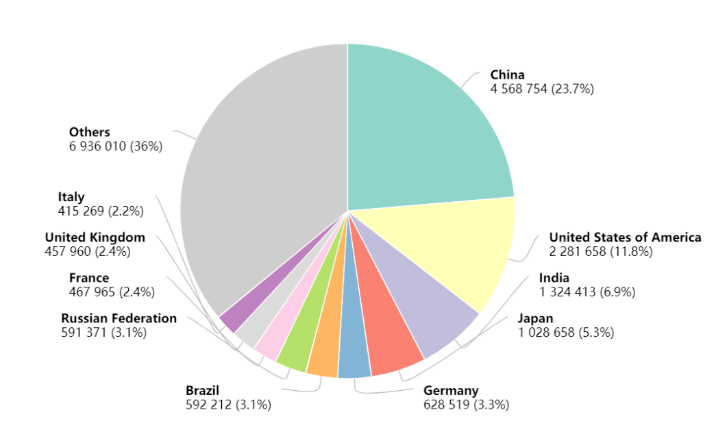
Number of new cancer cases by country in 2020
In 2020, there were 9.96 million cancer deaths worldwide, including 3million cancer deaths in China, accounting for 30% of the total cancer deaths. This is mainly due to the large number of cancer patients in China, which ranks first in the world.
The top ten countries with cancer deaths in 2020 are: 3million in China, 850000 in India, 610000 in the United States, 420000 in Japan, 310000 in Russia, 260000 in Brazil, 250000 in Germany, 230000 in Indonesia, 190000 in France and 180000 in Britain.

Number of cancer deaths by countries in 2020
The supremacy of lung cancer is unshakable, and the death toll is far ahead
In 2020, there were 4.57 million new cancer cases in China. Breast cancer ranked first in the world, but ranked fourth in China after lung cancer, colorectal cancer and gastric cancer.
In 2020, the top ten new cancer cases in China were: 820000 for lung cancer, 560000 for colorectal cancer, 480000 for gastric cancer, 420000 for breast cancer, 410000 for liver cancer, 320000 for esophageal cancer, 220000 for thyroid cancer, 120000 for pancreatic cancer cancer, 120000 for prostate cancer and 110000 for cervical cancer. These ten kinds of cancer accounted for 78% of the new cancer cases.
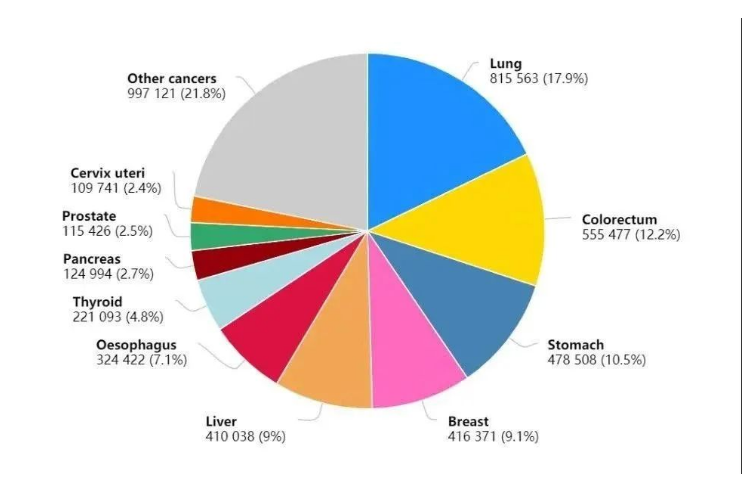
Top ten cancer types of new cancer cases in China in 2020
In 2020, the number of cancer deaths in China was 3million, and the number of lung cancer deaths was far ahead, as high as 710000, accounting for 23.8% of the total cancer deaths.
In 2020, the top ten cancer deaths in China were lung cancer 710000, liver cancer 390000, gastric cancer 370000, esophageal cancer 300000, colorectal cancer 290000, pancreatic cancer 120000, breast cancer 120000, nervous system cancer 70000, leukemia 60000 and cervical cancer 60000, which accounted for 83% of the total cancer deaths.
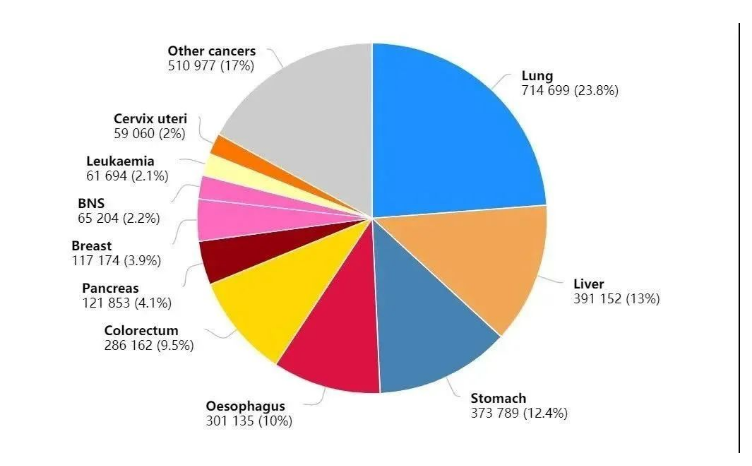
Top ten cancer types of cancer deaths in China in 2020
Chinese male data: lung cancer, gastric cancer and liver cancer remain the same
In 2020, there were 2.48 million new cancer cases among Chinese men, accounting for 54% of the total, of which lung cancer, gastric cancer, colorectal cancer and liver cancer were the most common.
In 2020, the top ten cancers in the number of new cancer cases among Chinese men were: 540000 for lung cancer, 330000 for gastric cancer, 320000 for colorectal cancer, 300000 for liver cancer, 220000 for esophageal cancer, 120000 for prostate cancer, 70000 for pancreatic cancer, 70000 for bladder cancer cancer, 50000 for thyroid cancer and 50000 for non Hodgkin's lymphoma. These ten cancers accounted for 84% of the number of new cancer cases among men.
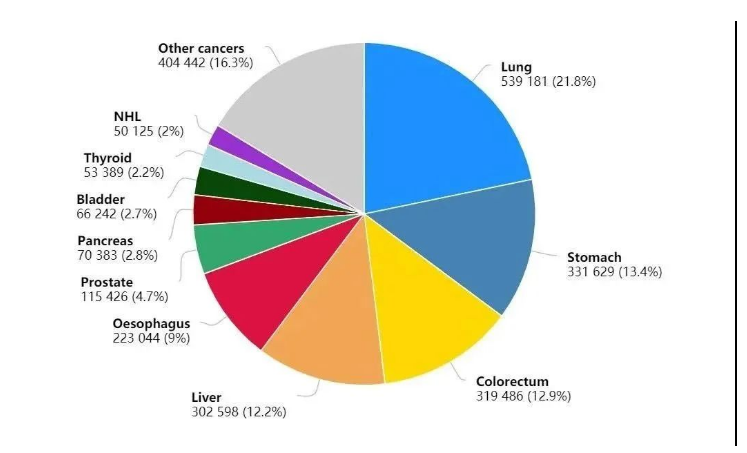
Top ten cancer types of new cancer cases among Chinese men in 2020
In 2020, there were 1.82 million male cancer deaths in China, accounting for 61% of the total. Among them, lung cancer, liver cancer, gastric cancer and esophageal cancer had the largest number of deaths.
In 2020, the top ten cancers in the number of male cancer deaths in China were: 470000 for lung cancer, 290000 for liver cancer, 260000 for gastric cancer, 210000 for esophageal cancer, 160000 for colorectal cancer, 70000 for pancreatic cancer, 50000 for prostate cancer, 40000 for leukemia, 30000 for cancers of the nervous system, and 30000 for non Hodgkin's lymphoma. These ten cancers accounted for 88% of the total cancer deaths.

Top ten cancer types of male cancer deaths in China in 2020
Chinese women: the new incidence of breast cancer surpasses that of lung cancer, reaching the top
In 2020, there will be 2.09 million new cancer cases in women, accounting for 46% of the total. Breast cancer, lung cancer and colorectal cancer will have the highest incidence.
In 2020, the top ten new cancer cases among Chinese women were: 420000 breast cancer, 280000 lung cancer, 240000 colorectal cancer, 170000 thyroid cancer, 150000 gastric cancer, 110000 cervical cancer, 110000 liver cancer, 100000 esophageal cancer, 80000 endometrial cancer and 60000 ovarian cancer. These ten kinds of cancer accounted for 81% of the new cancer cases among women

Top ten cancer types of new cancer cases among Chinese women in 2020
In 2020, there were 1.18 million female cancer deaths in China, accounting for 39% of the total. Lung cancer, colorectal cancer, gastric cancer and breast cancer accounted for the largest number of deaths.
In 2020, the top ten cancers in the number of female cancer deaths in China were: 240000 for lung cancer, 120000 for colorectal cancer, 120000 for gastric cancer, 120000 for breast cancer, 100000 for liver cancer, 90000 for esophageal cancer, 60000 for cervical cancer, 50000 for pancreatic cancer cancer, 40000 for ovarian cancer and 30000 for cancers of the nervous system. These ten cancers accounted for 83% of the total cancer deaths.
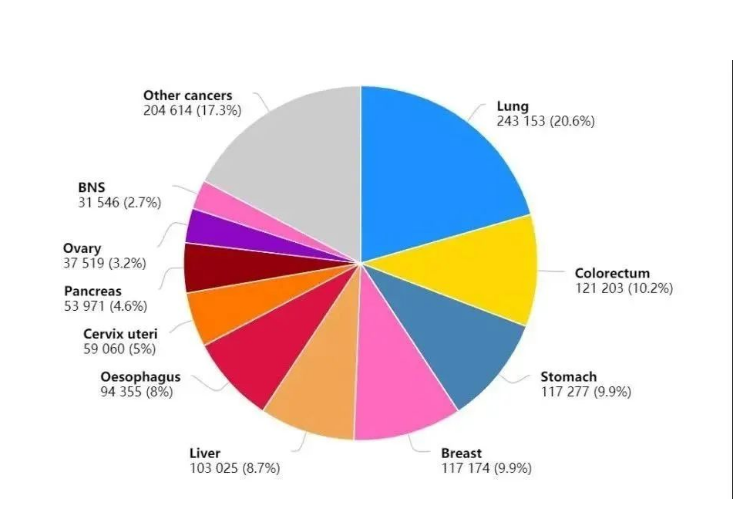
Top 10 cancer types of female cancer deaths in China in 2020
Globally, due to the intensification of population aging, it is expected that the cancer burden will increase by 50% in 2040 compared with 2020, and the number of new cancer cases will reach nearly 30million at that time. This is most pronounced in countries undergoing social and economic transition.
For China, the inclusion of cancer prevention and treatment interventions in the health plan will help to reduce the future cancer burden and promote the development of innovative anti-cancer drugs. The combination of "prevention + treatment" can better reduce the cancer burden and protect people's health.
Original link:
https://www.cn-healthcare.com/articlewm/20220607/content-1373428.html











